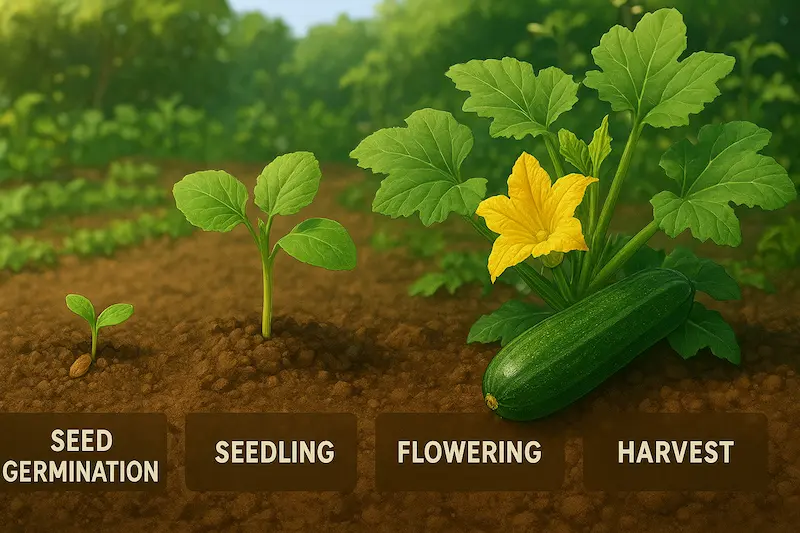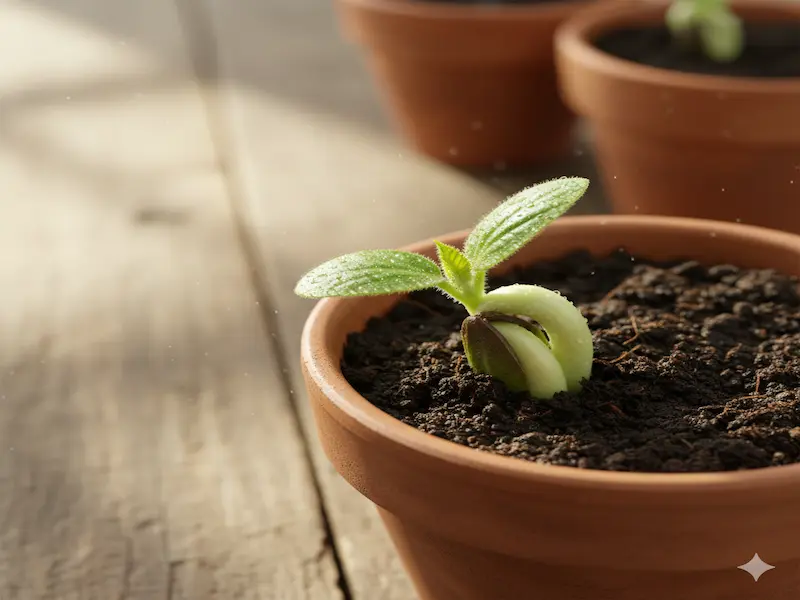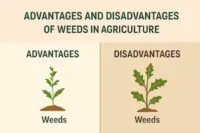Zucchini Growth Stages: Simple Guide from Seed to Harvest
Published: 18 Oct 2025
Growing zucchini is fun, fast, and tasty. You can pick fresh squash for many weeks. When you know the zucchini growth stages, you make better choices. You water on time. You feed at the right moment. You catch pests early. This boosts yield and cuts stress.

In this simple zucchini growing guide, we will cover the full zucchini life cycle. You’ll see the zucchini growth timeline from seed to harvest. You will also learn how fast zucchini grows and how to grow zucchini at home with confidence.
Why Understanding Zucchini Growth Stages Matters
Each stage needs different care. That is why timing matters.
- Watering: Young plants need steady moisture. Large plants require deep, less frequent watering.
- Feeding: Early growth likes nitrogen. Fruiting needs more potassium.
- Pest control: Tiny seedlings are delicate. Later, flowers and fruit need extra watch.
- Spacing and airflow: Plants can grow large. Good spacing stops disease and rot.
- Harvest timing: Picking at the right size keeps plants producing.
When you know the zucchini plant stages, you can plan your tasks. You will think at the right time. You will mulch when the soil is warm. You will prune leaves that shade fruit. This is how small changes make big harvests.
Zucchini Growth Stages: From Seed to Harvest
Below is the simple, week-by-week zucchini growth timeline. Your weather may shift the dates a bit. Warmer soil speeds things up. Cool, wet soil slows things down.
Seed Germination (Weeks 1–3)
What happens
- The seed swells and sprouts. This is zucchini seed germination.
- A tiny root grows down. A shoot grows up.
- Cotyledons (first seed leaves) open.
What to do
- Sowing zucchini seeds: Plant 1 inch deep in warm soil.
- Ideal soil temperature for zucchini: 70–95°F (21–35°C). Aim for 75–85°F.
- Use loose, well-drained soil with compost mixed in.
- Space seeds 18–24 inches apart for bush types. Give 3–4 feet between rows.
- Water after sowing. Keep the top 1 inch of soil moist.
- Full sun is best. Give 6–8 hours of sun each day.
Tips for faster sprouting
- Pre-warm the soil with black plastic or a clear cover.
- Pre-soak seeds for 4–6 hours before planting.
- Start seeds in biodegradable pots if nights are cool.

Seedling Stage (Weeks 3–5)
What happens
- Cotyledons feed the plant at first.
- True leaves appear next. They look more jagged and larger.
- Roots branch out and anchor the plant.
What to do
- Thin plants once true leaves show. Keep the strongest plant in each spot.
- Early zucchini plant care: Keep soil evenly moist, not soggy.
- Watering zucchini seedlings: Water at the base in the morning.
- Weed often so seedlings are not crowded.
- Give strong light. Sunlight requirements for zucchini are high. Aim for full sun.
Extra help
If seedlings look pale, feed them a gentle, balanced liquid fertilizer.
Protect from wind with small collars or a light cover.
Vegetative Growth (Weeks 6–10)
What happens
- Zucchini leaf growth speeds up.
- Zucchini stem development thickens at the base.
- Plants get bushy. Vines may sprawl in some varieties.
- First flowers appear. Male flowers often open before females.
What to do
- Space matters. Keep 18–36 inches between plants, depending on variety.
- Mulch once the soil is warm. This holds moisture and limits weeds.
- Fertilizing zucchini plants: Side-dress with compost at week 6–7.
- Use a balanced fertilizer (like 5-5-5) or compost tea every 2–3 weeks.
- Check for pests under leaves every few days.
- Remove a few tired lower leaves to improve airflow.
Flowering and pollination basics
- Zucchini flowering starts in this stage.
- Male flowers have thin stems. Female flowers have a tiny fruit behind the bloom.
- Bees help with the zucchini pollination process.
If pollinators are low, try pollinating zucchini manually:
- In the morning, pick a fresh male flower.
- Gently touch pollen to the female flower’s center.
- Or use a soft brush to move pollen.
Fruit/Root Formation (Weeks 10–14)
What happens
- After flowers are pollinated, zucchini fruit formation begins.
- Fruit grows fast in warm weather. It can grow an inch or more per day.
- Roots deepen to support growth and water uptake.
What to do
- Water deeply, 1–1.5 inches per week. Use your finger test. Soil should be moist 2–3 inches down.
- Keep leaves dry. Water the soil, not the leaves.
- Feed with a fertilizer higher in potassium to support fruit.
- Add a light compost side-dress when the first fruits set.
- Keep mulch in place to hold moisture and prevent splash onto fruit.
Blossom care and tips
- Zucchini blossom care: Avoid overhead watering during bloom.
- Support developing fruit with a small board or mulch. This prevents soil rot.
- If fruit is not forming, check pollination. Try hand pollinating for a week.
Maturation & Harvest (Weeks 14–16 and beyond)
What happens
- Plants hit peak size and production.
- Fruit matures very fast in the heat.
How to know when the zucchini is ready to pick
- Ideal size: 6–8 inches long and firm. Smaller is tender and sweet.
- Skin should be glossy. Dull skin means it is overripe and seedy.
Harvest methods and post-harvest care
- Cut the stem with clean pruners. Leave a short stub.
- Do not yank or twist. It can harm the plant.
- Pick every 1–2 days to keep plants producing.
- Store unwashed in the fridge crisper for up to a week.
- For the best flavor, eat within 3–5 days.
Notes on speed
- Wondering how fast zucchini grows? In hot weather, fruit can size up in 2–3 days.
- Many gardens start harvest around 45–60 days after sowing, depending on the warmth.
Common Challenges at Each Zucchini Plant Stage
Here are the most common zucchini pests and diseases, plus fixes you can use right away.
Powdery mildew on zucchini
Signs: White, dusty leaves.
Fix: Improve airflow. Water at the base. Remove the worst leaves. Spray 1 tbsp baking soda + 1 tsp liquid soap in 1 gallon of water weekly, or use a labeled fungicide. Start early.
Squash vine borer
Signs: Sudden wilt, sawdust-like frass at the stem.
Fix: Wrap lower stems with foil or cloth. Use floating row covers until flowering. If hit, slit the stem, remove the larva, and mound soil over the cut to re-root.
Cucumber beetles and aphids
Signs: Holes in leaves, sticky residue, and virus spread.
Fix: Yellow sticky traps. Hand-pick in the morning. Spray insecticidal soap for aphids. Use row covers early. Keep weeds down.
Zucchini leaves are turning yellow
Causes: Low nitrogen, overwatering, or root stress.
Fix: Side-dress with compost. Water deeply but less often. Check drainage. Do not let pots sit in saucers of water.
Overwatering zucchini plants
Signs: Limp leaves, soggy soil, fungus gnats, root rot.
Fix: Let the top 1–2 inches dry before watering again. Improve drainage. Add perlite to heavy soil.
Zucchini plant wilting in the heat
Signs: Midday droop on hot days.
Fix: This can be normal. Check soil moisture in the morning. If dry, water deeply. Add mulch.
Preventing zucchini rot (blossom end rot and fruit rot)
Causes: Uneven watering, calcium issues, fruit on wet soil.
Fix: Keep moisture even. Add mulch. Place fruit on a dry surface. Do not over-fertilize with nitrogen.
Poor fruit set
Causes: Low bee activity or cool weather.
Fix: Hand pollinate in the morning for a week. Plant flowers nearby to attract bees.
Container and small-space tips
Use a 10–15-gallon pot for one plant. Bigger is better.
Water more often in pots. They dry faster.
Feed lightly every 2 weeks during fruiting.
The train leaves and steams to one side for airflow.
How My Best Vegetables Help Farmers and Gardeners
At mybestvegetables.com, we share simple and science-based vegetable farming guides to help both beginners and professionals grow healthier crops. Our step-by-step tutorials, growth stage breakdowns, and care tips make vegetable cultivation easy and successful for everyone. If you want to learn more about lavender growing stages or lettuce growth stages, then visit this platform.
Conclusion:
Growing zucchini is quick and rewarding. With patience and steady care, you will fill your kitchen with fresh squash. Use this zucchini growth timeline as your map. Watch the zucchini plant stages, and act at the right time. When you understand zucchini growth stages, you harvest more and stress less.
Ready to start? Plant a few seeds today and enjoy your first harvest soon. For more zucchini gardening tips and other crops, visit mybestvegetables.com.

- Be Respectful
- Stay Relevant
- Stay Positive
- True Feedback
- Encourage Discussion
- Avoid Spamming
- No Fake News
- Don't Copy-Paste
- No Personal Attacks



- Be Respectful
- Stay Relevant
- Stay Positive
- True Feedback
- Encourage Discussion
- Avoid Spamming
- No Fake News
- Don't Copy-Paste
- No Personal Attacks



